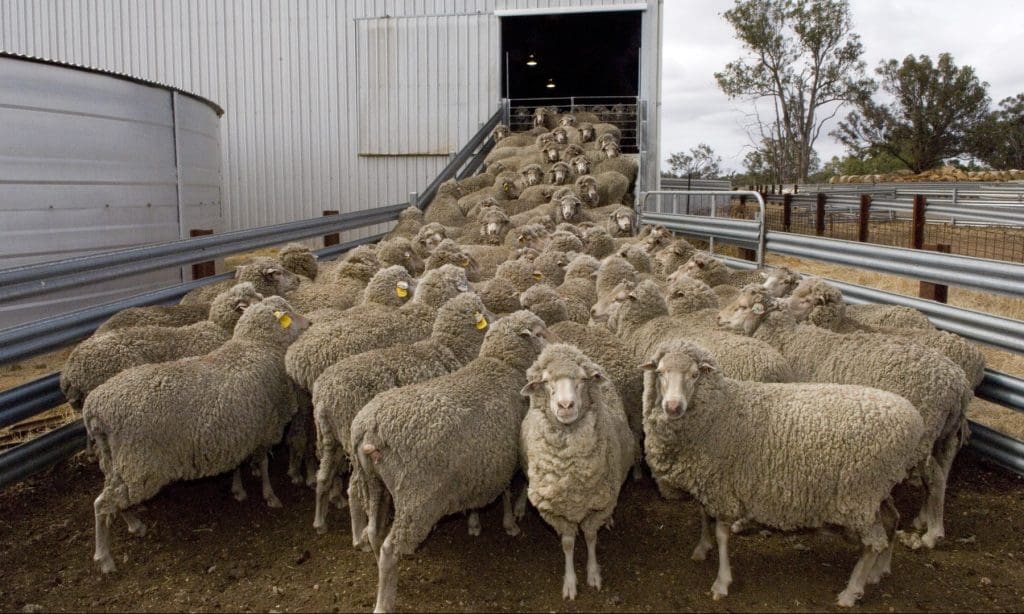
Merino sheep in full wool in race before shearing.
AUSTRALIA’S shorn wool production is estimated to be 318 Mkg greasy in 2023/24 and forecast to drop further to 285 Mkg greasy in the following year.
The Australian Wool Production Forecasting Committee today released its latest forecasts, expecting this year’s wool output to drop 3.1 percent below its 2022/23 season estimate.
The number of sheep shorn is estimated at 71.6 million head, up 0.1pc; however, average cut per head is estimated to have reduced 3.3pc this season to 4.44 kg greasy due to poorer seasonal conditions.
The AWPFC’s second forecast of shorn wool production for the 2024/25 season is 285 Mkg greasy, a 10.1pc decrease on the 2023/24 forecast. The number of sheep shorn in 2024/25 is forecast at 64.2 million, down 10.3pc. Average cut per head is expected to be comparable with 2023/24 at 4.45 kg greasy.
Committee chairman Stephen Hill said the deterioration in seasonal conditions in western Victoria, South Australia, Western Australia, Tasmania and south-west New South Wales since the April meeting prompted the downward revision of the April forecast.
“Held-over lambs and older breeding ewes that were retained in the flock at the beginning of the season have now been turned off prompted by the recovery of sheep meat prices in recent months,” he said.
“Sheep shorn numbers were comparable to the 2022/23 season at 71.6 million head, up 0.1pc.
“However, the relatively poorer seasonal conditions in 2023/24 reduced average cut per head to 4.44 kg greasy, down 3.3pc,” he said.
“This is close to the long-term average following historically high per head production in 2022/23.”
AWTA key test data for the 2023/24 season show a 0.1 micron decrease in mean fibre diameter to 20.7 microns, a 1.9 mm decrease in staple length to 86.9 mm, 0.6pc lower yield to 65.3pc and 0.1pc less VM (2.3pc). Staple strength increased to 35.2Newtons/kilotex, up 0.5 N/ktex.
The weighted average fibre diameter of firsthand Merino wool auctioned in 2023/24 was 18.8 microns (down 0.2 microns on the 2022/23 season).
The forecasting committee said New South Wales continues to have the largest sheep flock, shearing 26.6 million head (up 2.7pc) and producing 119.5 Mkg greasy wool (up 0.4pc). Victoria shore 15.6 million sheep (down 3.1pc) and produced 65.6 Mkg greasy (down 6.3pc) with Western Australia producing 55.0 Mkg greasy (down 9.3pc) from 12.5 million sheep shorn (down 4.2pc).
AWTA wool test volume for the 2023/24 season (334.5 Mkg greasy) was down by 3.8pc on a year-on-year basis. Firsthand offered wool at auction during 2023/24 was not different to the amount offered in 2022/23 at 298 Mkg greasy.
The August AWPFC estimate includes a clean wool estimate for average cut per head and shorn wool production. For the 2023/24 season the yield (%, Schlumberger dry top and noil yield) from the AWTA key test data was used to calculate the clean average cut per head and clean shorn wool production.
The committee said poor seasonal conditions in western Victoria, Tasmania, South Australia and Western Australia prompted it to revise its second forecast of shorn wool production for the 2024/25 season down to 285 Mkg greasy. Also the May 2024 Sheep Producer Intentions Survey (SPIS) indicated a reduction in producer sentiment in the wool and sheep meat sectors compared to sentiment in May 2023. Seasonal conditions, feed availability, input costs, availability of labour as well as sheep and wool prices are the key factors impacting on-farm decision making.
The Bureau of Meteorology is forecasting average to above average median rainfall in Queensland, New South Wales, Victoria and Tasmania from September to November, but below average rainfall is expected in South Australia and Western Australia. Producers in most states will reassess their stocking rate if feed availability remains limiting in spring, the committee said. On-farm stock water availability leading into summer is another key consideration.
The AWPFC said it will review its 2024/25 forecast in December when the seasonal and market outlook becomes clearer.

The death spiral for wool has begun.
Poor prices, high production costs, lack of skilled labor, increased compliance, ageing workforce and lack of direction by the industry leaders.
Prices may increase at some point, but the other factors are not easily fixed.
No surprises in the drop in wool production.
The article failed to mention the price of wool. It is disgracefully low, which would have more to do with it than almost any of the other reasons given.
If farmers are making money out of an enterprise they will do almost anything to keep that enterprise. At today’s prices and the costs involved in producing it, wool is done, and production will continue to decline.